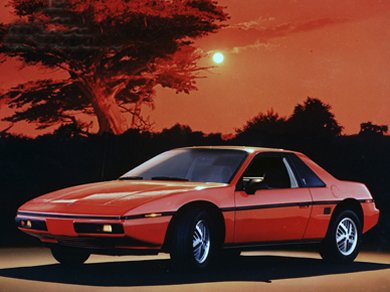
By Murf The Mongolian
American manufacturers never delved into mid-engined sports cars before the 1980s because they believed such cars lacked profitability. However, at around the same time that Toyota launched their legendary MR2, General Motors decided to try their hand at it with the Pontiac Fiero.
In car-crazy America, the time seemed ripe for an affordable mid-engined sports car. However, the General gave its Pontiac division a tight budget for the development of the Fiero. This meant its double-wishbone front suspension was sourced from mediocre Chevy Chevette, and the engine and rear MacPherson strut suspension from GM's X-body cars.
The innovative chassis was a steel space-frame, clad with injection-molded plastic body panels that made its way to Saturn later. To reduce NVH, the engine, transaxle and lower control arms of rear suspension were all mounted on a subframe, which was attached to the chassis via rubber bushings. The gas tank was located inside the transmission tunnel so that gasoline levels would not affect handling. The radiator was mounted on the nose, and coolant lines ran through the transmission tunnel to the engine.
Of course, the attractive Fiero was a strong seller as soon as it debuted. Its looks successfully hid its dynamic shortcomings and build quality. However, sales started to decline over the years. A massive recall due to engine fires ruined its short-term reputation. Sales dropped friom 137,000 in 1984 to only 26,000 units in 1988. By then, the General had decided to pull the plug.
The Fiero was much larger and heavier than the MR2, although it was compact by by American standards. Complaints included a cramped cabin and limited luggage space. Its frontal trunk was almost fully occupied by the spare tire, with a very short trunk in the rear. Space efficiency ws not its strong suite.
The biggest problem of Fiero was performance. At launch, it was powered by the poorest engine of the class, the 2.5L "Iron Duke" push-rod inline-4 from GM's "economy" sedans. It was heavy and reluctant to rev, producing only 92 hp at 4000 rpm, sounded horribly loud near redline and needed 11 seconds to do the 0-60 mph run, partly due to the outdated 4-speed manual gearbox. As for top speed of only 103 mph, the smaller and more powerful MR2 was running rings around it.
To help sales, GM introduced a 140 hp 2.8L push-rod V6 in 1985, and then added a 5-speed manual gearbox for the V6 in 1986. These improvements led to better 0-60 mph times closer to 8 seconds, while and raising top speed to 125 mph. But to counteract the low-revving V6, Toyota had already introduced a supercharged MR2 that obliterated the Fiero yet again.
Problems with the Fiero also extended to its handling. With its wide track, 44:56 weight distribution and independent suspension, the Fiero was the perfect sports car on paper. But the solid ingredients did not translate into a good dish, as the limited budget and unremarkable parts-bin components came together in a poorly-tuned package. The mid-engined Fiero was prone to understeer. But while it approached its cornering limit with moderate understeer, lifting off the throttle mid-corner would could cause sudden oversteer. So track-going owners would fight understeer and oversteer, while the competition passed them by with their neutral-handling "proper" sports cars. Soft subframe bushings and spring rates also caused imprecise handling and excessive body roll. The unassisted steering was hampered by a lot of kickback and little actual feedback, while being painfully heavy during parking. High-speed stability was also a problem above 80 mph due to the front-end lift it generated. Ultimately, driving the Fiero quickly at full tilt was a tiring and frustrating experience.
The Fiero actually improved year after year, looking better after its mid-life facelift and receiving better suspension in its final year of production. However, it was too late by then. Looking back now, the Pontiac Fiero has a massive fan following and remains the first and only mainstream American mid-engined production car.
More Classics...